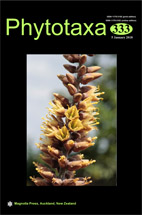Abstract
Based on the morphological study of ca. 470 specimens and geographical studies, we here propose the recognition of six morphotypes within the South American Pteridium esculentum (= P. arachnoideum s.l., or P. aquilinum var. arachnoideum sensu Tryon, or P. esculentum subsp. arachnoideum sensu Thomson). Three of them are widely distributed and well-defined, and we regard them as subspecies of P. esculentum: P. esculentum subsp. arachnoideum s. str., P. esculentum subsp. campestre, comb. et stat. nov., and P. esculentum subsp. gryphus. The other three are more rare. One of these is a pedomorphic form of P. esculentum subsp. arachnoideum, which we name as P. esculentum subsp. arachnoideum var. paedomorficum, nom. nov. The other is a glabrous form of P. esculentum subsp. gryphus, which we name P. esculentum subsp. gryphus var. harpianum, var. nov. The third is a putative hybrid between P. esculentum subsp. arachnoideum and P. esculentum subsp. campestre. All six taxa are keyed, described, illustrated, mapped, and discussed. Pteridium esculentum subsp. arachnoideum s. str. forms an arc of distribution from eastern, to southern, to western South America (but not occurring west of the Andes); Pteridium esculentum subsp. campestre forms an arc of distribution from northeastern Brazil to northern South America (not occurring west of the Andes either); and P. esculentum subsp. gryphus forms an arc of distribution from western to northern South America (occurring also west of the Andes and in Galapagos). This one is morphologically more similar to the Australasian P. esculentum subsp. esculentum.

